Sending a PDF document to customers has many advantages. As well as maintaining the format of the original file, PDFs work on all operating systems and are generally easy to view and share on a variety of devices. You can even lock your PDF files and protect them with a password.
These features are beneficial for sales teams and marketers because they ensure that the document appears correctly for the customer and that the customer can easily access critical information.
Fortunately, you don’t need a specialized PDF converter, it’s easy to save your Word file in a PDF format using the Save As feature and selecting PDF from the Export Formats submenu.
But this might not always be the best option, especially if you need to do more with your documents, like create contracts or convert a Word document to a PDF that requires a digital signature.
So, we’re going to take a look at how to convert Word documents to PDFs using PandaDoc.
How to convert a Word document to PDF (.docx to .pdf) using PandaDoc
Below, you’ll learn how to convert a Word document to a PDF using PandaDoc. We’ll explore all the steps you need to follow to convert files from a Word document format to a PDF file format.
Keep in mind that the PandaDoc Editor can accept files from your desktop as well as other sources and integrations like Google Drive, Box, and Dropbox.
To use PandaDoc, you’ll need an account. Sign up for a 14-day free trial or our Free eSign Plan to get started!

1. Upload your Word file (.doc/.docx) to the PandaDoc editor
After signing up for your PandaDoc account, navigate to your PandaDoc dashboard. You can access this by clicking on the top icon on the left sidebar (four small squares).
In the top right-hand corner of the interface, find the “New Document” button. Select “Upload” and then the upload window will appear.
On your computer, choose the docx file that you want to convert to a PDF, and drag-and-drop it into the upload window to begin uploading the document to PandaDoc.
Once the upload is complete, you’ll be asked whether you’d like to convert your document to an editable PandaDoc file.
Select “Convert Document” and wait for the document to process.
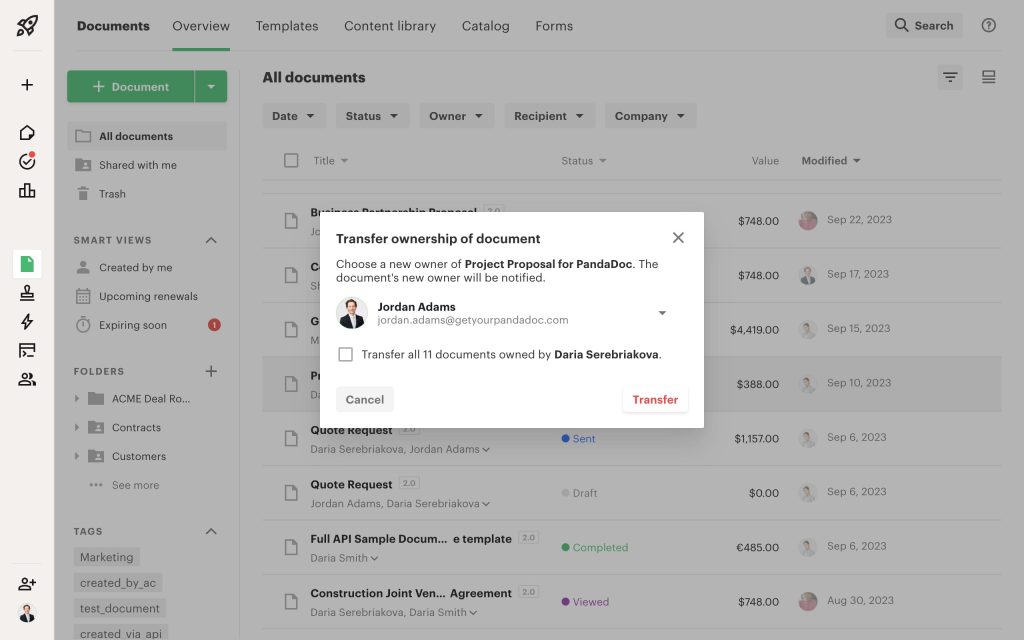
2. Use PandaDoc tools to add tables, images, text, and more
Once the document processes, you’ll find yourself in the PandaDoc editor. From there, you can edit your document as though you were still using Microsoft Word or Google Docs.
At this stage, PandaDoc acts like a word processor.
Use this opportunity to format your document. Add images (.jpg and .png), pricing tables, custom page breaks, or even a table of contents to your document. Using the drag-and-drop feature, simply drag content blocks and fields onto the document to add them to the layout.
It’s important to make any final alterations before you create your PDFs. Once the PDF conversion is complete, you won’t be able to make any formatting changes.
3. Optional: Add a signature field
If you’re converting a Microsoft Word document to a PDF that requires a digital signature, drag a signature field into your document.
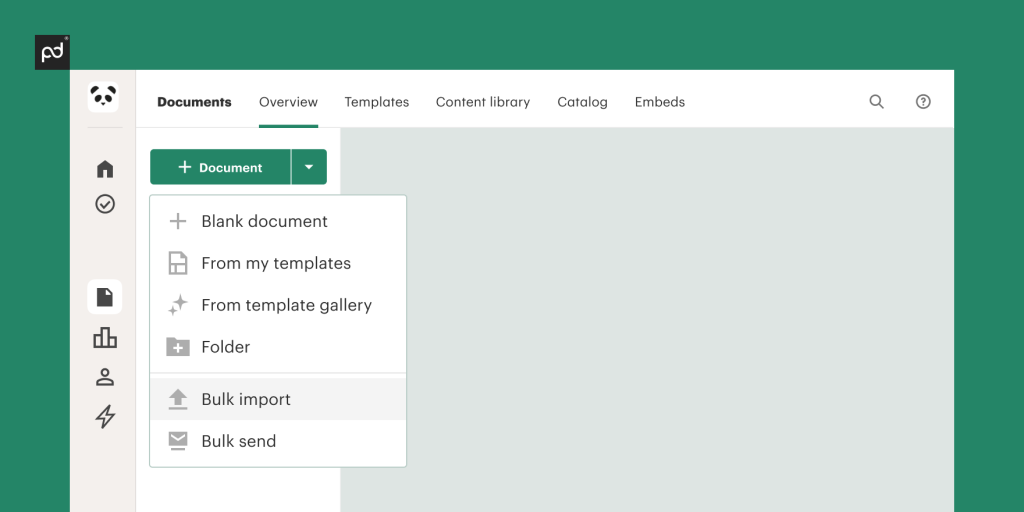
Like all PandaDoc “Fields”, the signature box can be dragged onto both locked and unlocked file types using the PandaDoc editor.
This means that if you were to upload a PDF to PandaDoc, you wouldn’t be able to edit the original text of the document. However, you’ll still be able to add signatures, text fields, checkboxes, and initial fields without a problem.
These PDF tools allow you to capture digital signatures through PandaDoc even if they weren’t created or formatted by the PandaDoc editor. It’s a fast and easy way to add signature requirements to contracts and agreements before you send them out.
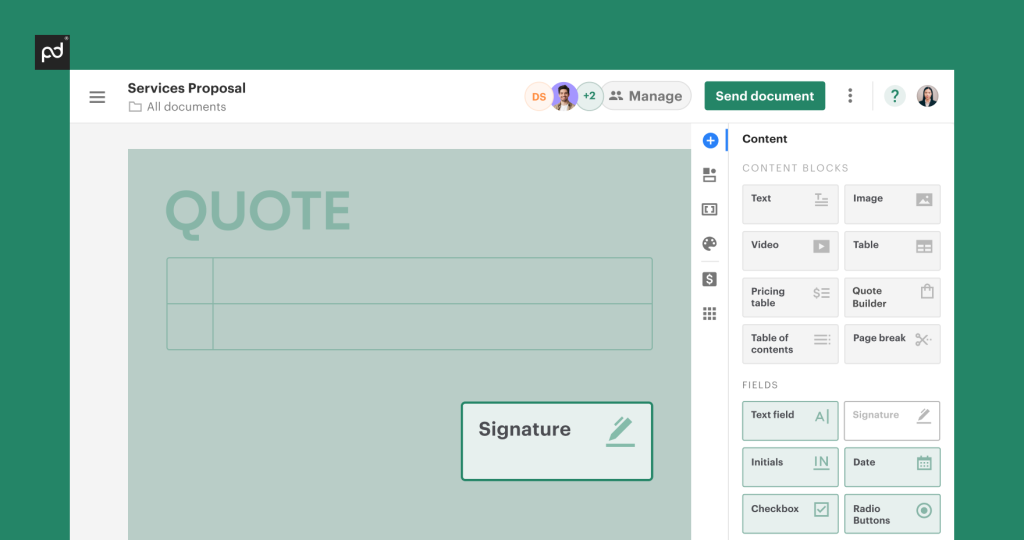
4. Optional: Add a payment gateway
If you’re sending a contract or a proposal agreement to collect a payment, you can save yourself the trouble of preparing an invoice by connecting your document to a payment gateway.
When you do this, your customers will be able to pay you directly from your PandaDoc document.
This is a great tool for sales teams, freelancers, and business owners who need to collect an upfront payment before starting work.
It’s easy to send milestone invoices through PandaDoc, as well. You can even use one of the invoice templates from our template library to help you get started.
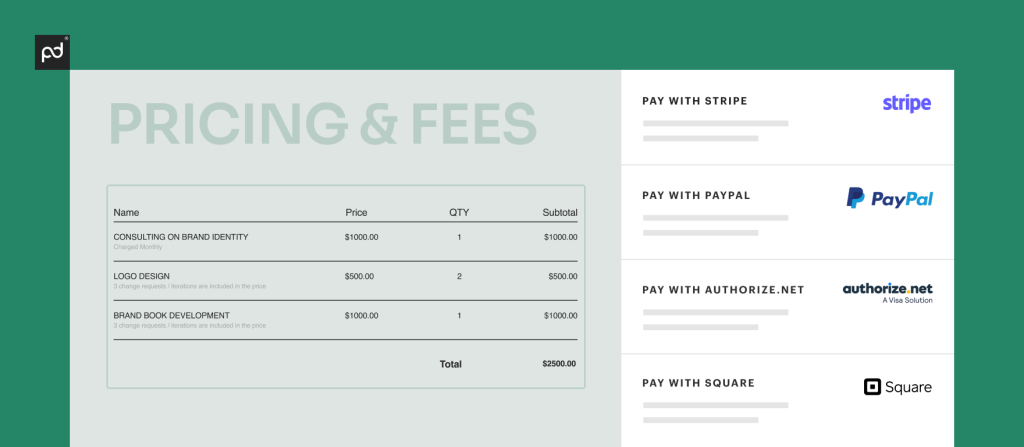
5. Convert your document to PDF or send electronically for digital signature
At this stage, you’ve made all the necessary edits to your document, and it’s time to download or send your new PDF.
You could download your PDF to your hard drive or use PandaDoc to send your documents for signature with the help of tools such as the DocX converter.
A. Download to hard drive
Select the three vertical dots in the upper right-hand corner of the PandaDoc editor, then select “Download.”
Downloading the file will save it to your hard drive as a PDF. Then you’ll be able to attach the file to your emails and send it to customers.
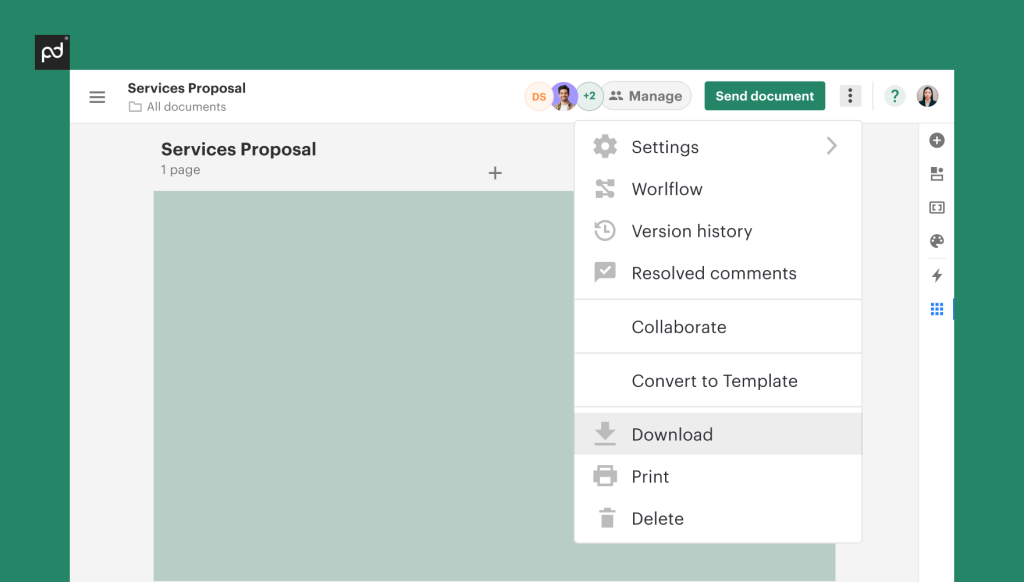
B. Send documents using PandaDoc
This is our recommended option. Rather than downloading your document as a PDF, use PandaDoc to allow recipients to add digital signatures to PDF documents.
By clicking on the “Send Document” button in the upper right of the screen, you can choose to send your document by email or share it directly with your customers via a link.
This keeps your document within the PandaDoc platform so that you can continue to receive insights and updates on your document performance. Our document analytics notify you when someone has viewed your document, how long they spent on each page, and how many times they returned to it.
You can use these insights to accelerate your sales process, get critical documents signed, and close deals even faster.
How to save a document as a PDF with MS Word
We’ve covered how you can create a document in PandaDoc and convert it to a PDF. We’ve also covered how to add digital signatures to PDF documents. But these aren’t the only ways you can change your Word doc into PDF format. It’s also possible to print your document directly as a PDF.
Let’s find out more about how to print and save your document this way:
Print as PDF
To print a Word document as a PDF, open the file you want to print. Then, choose “File” and then “Print.” Alternatively, hit “Ctrl+P” on your keyboard. This will open the Print menu.
Within the Print menu, click on “Printer.” A drop-down menu will appear. Scroll through the drop-down options until you reach “Microsoft Print to PDF.” This will also offer you many other options, including the selection of pages to print and more.
Doing this not only lets you print your document in PDF format, but it also creates a new version of your file in PDF format. So, even if you don’t have a printer, you can still use the Print to PDF function to convert your Word doc to a PDF.
Save as PDF
The easiest way to save a document as a PDF with MS Word is to select “Save As” and scroll down to “PDF” in the options field.
First, open the document you want to save as a PDF. Next, head to the “File” tab. Within the “File” tab, find the “Save As” menu. Click “Save As.” You’ll be presented with a range of options.
Click “Browse,” and select a location for your document to be saved (i.e., on your hard drive, within a specific folder, or on cloud storage platforms, such as OneDrive). Having picked a location, head to “Save As Type,” which you’ll find under the file name. Scroll through the options until you find “PDF.”
Click “PDF” followed by “Save” and hey presto! You’ve saved your Word document as a PDF.
However, if you want to insert a signature in Word, you’re better off working through PandaDoc than simply saving your document as a PDF and hoping that it will remain secure!
Why you should avoid digital signing with Microsoft Word
Just like converting docs to PDFs, you should note that advanced features like digital signing can be done from within Microsoft Word.
This is different from inserting a picture of a signature, which is also possible to do with Word documents.
The problem with digitally signing documents with Microsoft Word is that, unless you have a valid signing certificate from a certificate authority, there’s no legal authority behind the digital signature because the software can’t ensure the authenticity of the sent document.
While the signature feature is built into Word, the certificate must be purchased separately for a small cost.
A better digital signing solution for sales teams
Even if you take all the necessary steps to authenticate digital signatures that are added to documents in Microsoft Office, we still don’t recommend this solution for one reason; sharing a signed document is tedious.
Once you’ve signed your document, you’ll still need to share it with decision-makers, project stakeholders, and key contacts. Unfortunately, you can’t send multiple copies of this document at the same time. To ensure the integrity of the digital signature, you can only send the most updated version of the document to the next contact on your list — one by one.
If that sounds like a painful process, you’re absolutely right. It’s one of the main reasons that digital signing solutions like PandaDoc exist!
We use cloud-based technology to bring your customers to a single document rather than sending a single document to each customer one by one.
By converting your Word doc files to PDFs using the PandaDoc editor and creating a signing solution on our platform, you can dispatch important documents to customers at lightning speed, make changes on the fly, and keep your sales process moving forward.
Want to learn more? Sign up for a 14-day free trial and start building better documents today. Or, if you just want to upload existing documents for digital signature, sign up for our Free eSign plan!


